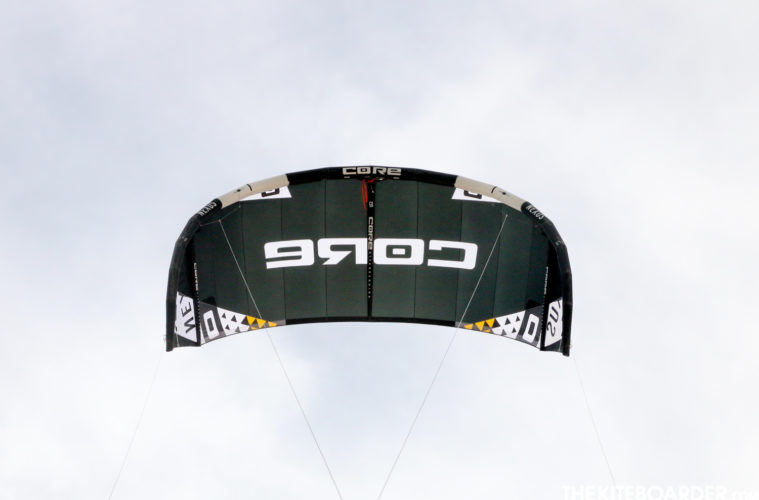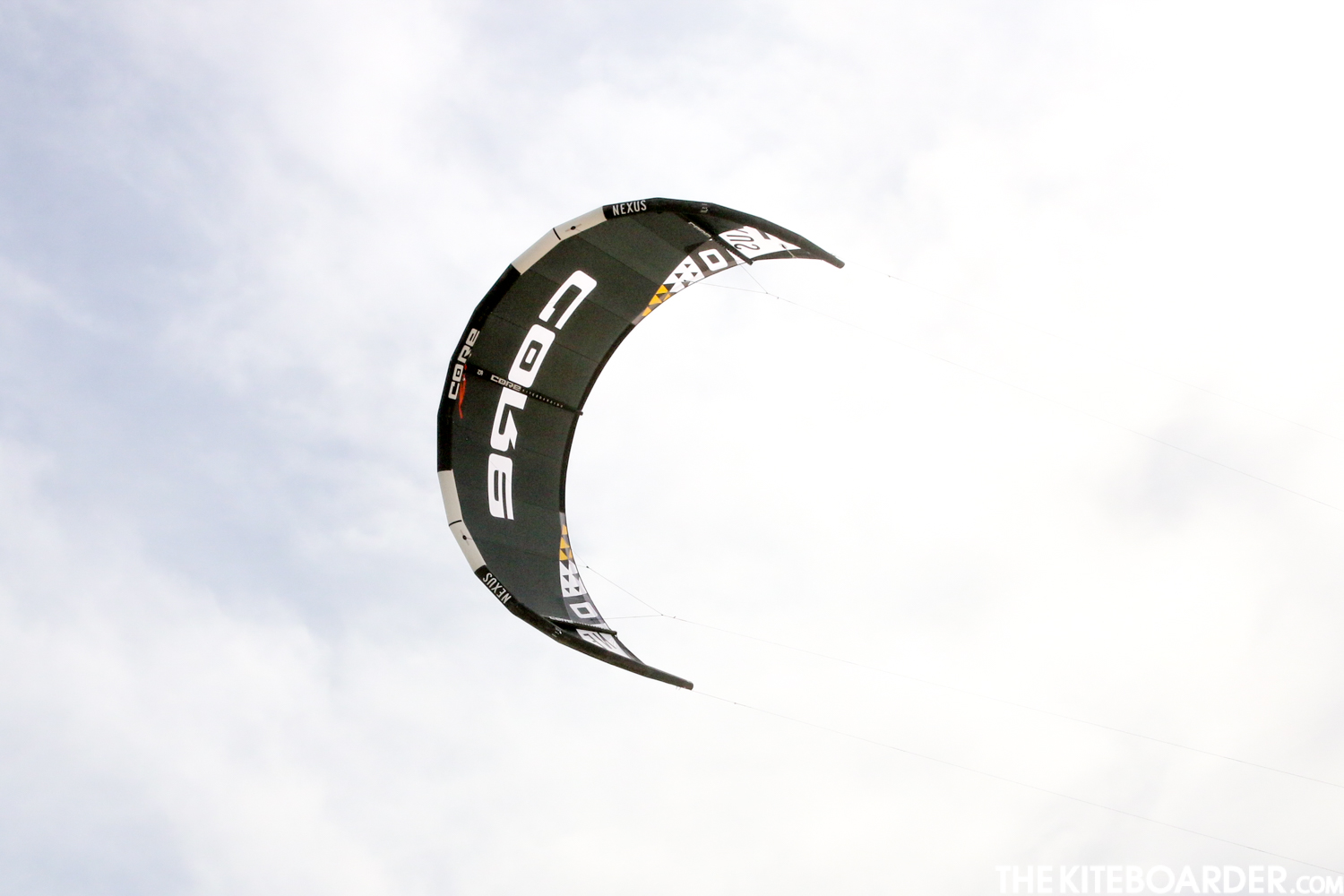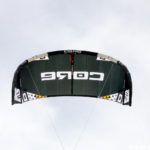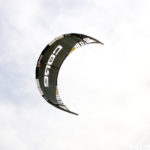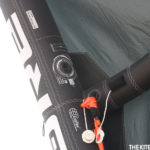Sizes Available: 15, 17m
Sizes Tested: 15, 17m
Core Says:
Treasure your local spot’s mid-afternoon summer breeze with our newest and most advanced light wind fun machine. Its super light, three strut construction, and fully customizable handling will have you grinning like silly in marginal conditions. Yes, it’s possible to make lines on your favorite break when others can’t. And yes, you can practice new tricks on the Nexus LW in less than perfect conditions.
Visit for more info: www.corekites.com/us/kites/nexus-lw
TKB Says:
A lot of kite companies make a single light wind kite and to accomplish that, they take one model and size it up for the desperate souls who are stuck groveling in sub-standard kite conditions. That does not hold true for Core Kiteboarding. Our friends from Germany have taken each one of their dedicated discipline platforms and built highly tailored purpose-specific light wind kites for the average Joe who doesn’t happen to live next to a thermal wind machine. To that end, Core makes its Nexus in 15 and 17m sizes to maximize surf and freestyle sessions in less than stellar conditions. The Nexus LW features Core’s proprietary inflation valve that requires a normal size pump hose without an attachment on the end; just insert your hose into the valve and rotate to lock. With the large size aperture, the larger kites inflate fairly quickly with minimal pump induced exhaustion. The valve stays closed until you put a plastic finger (hidden in a pocket of the center strut and attached by a small tether) into the valve to allow the air to deflate. The Nexus LW canopy uses CoreTex Light, which means that it shaves weight by using a lighter ripstop material in order to shed some weight. The front bridle utilizes two pulleys and a slider to adjust the kite’s angle of attack and allows the user to choose between three settings: ‘Wave, All Around, and Freestyle.’ Wave is the attachment farthest forward for more depower, and Freestyle is farthest back, with All Around being the factory setting. The wingtips offer three adjustment settings to select between ‘Medium, Easy and Super Easy,’ with the factory set to Easy in the center. The front bridle pigtails end in larks head loops and the wingtip pigtails end in three knots.
The Nexus with its 3-strut airframe is the jack of all light wind trades in the Core lineup. It takes its small struts and light canopy material and serves up decent pulling power for those who have their eyes on riding waves and an assortment of freestyle. The Nexus has slightly lower bar pressure than that of the super grunty XR6 and feels a bit more maneuverable with slightly quicker turn initiation and faster overall turning speeds. The Nexus might not deliver quite the heavy pulling power and vertical lift of the XR6 LW, but it does offer more well-rounded handling that might prove more useful for surf-minded riders and those that unhook and push the freestyle dimension. The power delivery on the Nexus feels intuitive and progressive, perhaps a bit less positive as the punchy feel you get with the XR6 and offers just a bit more depower when the wind spikes and you’ve got more canopy than you need. If you want to split hairs, you can adjust the CIT front bridle settings, by moving the attachment setting forward to wave to increase the pivoty feel of turns or shift back to get a slower turn that generates more power through the arc. While the XR6 wants to claw for the front of the window and generate lift, the Nexus is more user-friendly and much happier drawing lines in the middle of the window. With more drift, the Nexus will rock back and float with you as you cutback on waves and will load and slack a bit better for unhooked maneuvers. Can the light wind Nexus jump? Yes it’s faster turning might be more intuitive, but it doesn’t have quite the vertical pop of the XR6. The Nexus has the power most riders need with good upwind ability and the all around user-friendly handling that delivers fun surf and freestyle in otherwise struggle-fest winds.
The Core line of bars is incredibly diverse, starting with the Sensor 2, Sensor 2S and Sensor 2S Pro. We tested the Sensor 2S and Sensor 2S Pro; the main difference between the two is the Pro takes the standard titanium chassis and wraps it with carbon for lower weight and uses Tectanium flying lines for lower drag/windage (see the Xlite review for our thoughts on the new foil bar).
Both the Sensor 2S and 2S Pro are dual adjustable length bars (46/52 cm) designed to control all size kites with the center lines ending in knots and the outside lines in loops. Both versions of this bar come with four line-length extension options for those that want to vary their line lengths (choose between 18/20/22/24m by removing extensions). The throw/power line utilizes two PU-coated Tectanium lines (one of them is the safety depower), a replaceable plastic insert, no sliding stopper and a non-removable donkey dick. The double throw/power lines offer incredible durability and also auto-untwists the center lines when you sheet in the bar. The single centerline safety depower system utilizes a high V, and routes through the power lines for a very clean design. These bars also offer above bar depower and a custom clam cleat with a Velcro tuning handle to keep the depower control toggle from tangling.
Core bars have long been known for their twisting quick release with auto swivel ”˜S-System’ that doubles as a quick-release guard and integrates ceramic bearings for longevity. As we have said before, it’s an effective system if you practice with it and is less prone to accidental releases. Yet, it is immensely important that riders new to the system should dial in some muscle memory so they’re ready to address any problems in a pinch. The length of sheeting/throw can be adjusted for varying arm lengths of kiters or the type of riding. The non-molded foam floats are connected to the bar ends with the tips of the bar being hard. While the outside leader lines allow riders to adjust the length of the outside lines for stretch or tuning (by choosing between two knots), the bar ends are easily swapped between 46/52cm by changing to a separate knot on the bar end. The bar’s center insert has a Core logo on one side and a stop logo on the other to prevent you from grabbing the bar backward, which is a nice safety feature. One of the most noticeable aspects of this control bar is that it weighs virtually nothing yet you get all these features. The grip is a medium plush stamped grip with a fairly narrow diameter and small but sufficient bar end winders with non-retractable bungees finish off the bar. The purists on our testing team gave top marks for the Sensor’s streamlined lightweight feel and overall simplicity while incorporating the major features.
Visit for more info on the bar: www.corekites.com/us/bars/range

Want to view all our 2020 Freeride, Light Wind and Wingsurf Gear Reviews in one convenient digital guide? Get free access HERE. If you’re already a subscriber, thank you for your support! Log into your account to view our 2020 Freeride Gear Review Guide.


